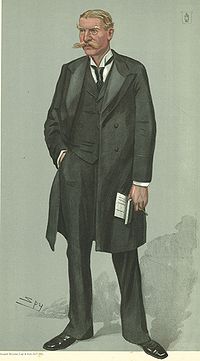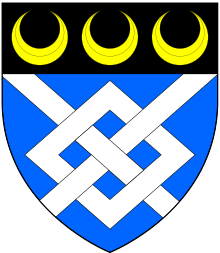Alexander Fuller-Acland-Hood, 1st Baron St Audries
The Lord St Audries | |
|---|---|
 "1st Conservative Whip". Fuller-Acland-Hood as caricatured by Spy (Leslie Ward) in Vanity Fair, November 1906. | |
| Parliamentary Secretary to the Treasury | |
| In office 8 August 1902 – 4 December 1905 | |
| Monarch | Edward VII |
| Prime Minister | Arthur Balfour |
| Preceded by | Sir William Walrond, Bt |
| Succeeded by | George Whiteley |
| Member of Parliament for Wellington | |
| In office 1892–1911 | |
| Preceded by | Charles Elton |
| Succeeded by | Dennis Boles |
| Personal details | |
| Born | 26 September 1853 |
| Died | 4 June 1917 (aged 63) |
| Nationality | British |
| Political party | Conservative |
| Spouse |
Hon. Mildred Eveleigh-de-Moleyns
(m. 1888) |
| Children | 4 |
| Parents |
|
| Relatives | Dayrolles Blakeney Eveleigh-de-Moleyns (father-in-law) |

Alexander Fuller-Acland-Hood, 1st Baron St Audries PC (26 September 1853 – 4 June 1917), known as Sir Alexander Fuller-Acland-Hood, Bt, until 1911, was a British Conservative Party politician. He served as Parliamentary Secretary to the Treasury (Chief Whip) under Arthur Balfour from 1902 to 1905.
Background
[edit]Fuller-Acland-Hood was the son of Sir Alexander Fuller-Acland-Hood, 3rd Baronet, by his wife Isabel, daughter of Sir Peregrine Palmer-Fuller-Acland, 2nd Baronet. He was a descendant of Alexander Hood, uncle of Lord Hood and Lord Bridport. He succeeded his father in the baronetcy in 1892. In 1905 he also succeeded his kinsman as 6th Baronet of Hartington Hall.[2]
Political career
[edit]Fuller-Acland-Hood sat as Member of Parliament for Wellington, Somerset from 1892 until 1911.[3] He was appointed Vice-Chamberlain of the Household under Lord Salisbury in 1900,[4] a post he held until November 1902,[5] and then served as Parliamentary Secretary to the Treasury (Chief Whip) under Arthur Balfour from August 1902 until 1905.[6] He was sworn of the Privy Council in 1904[7] and raised to the peerage as Baron St Audries, of St Audries in the County of Somerset, in 1911.[8]
Family
[edit]Lord St Audries married the Hon. Mildred Rose Evelyn, daughter of Dayrolles Blakeney Eveleigh-de-Moleyns, 4th Baron Ventry, in 1888. They had two sons and two daughters. He died in June 1917, aged 63, and was succeeded in his titles by his eldest son, Alexander. Lady St Audries died in October 1949.[2]
References
[edit]- ^ Montague-Smith, P.W. (ed.), Debrett's Peerage, Baronetage, Knightage and Companionage, Kelly's Directories Ltd, Kingston-upon-Thames, 1968 , p. 974
- ^ a b thepeerage.com Alexander Fuller-Acland-Hood, 1st Baron St. Audries
- ^ "Alphabetical index of MPs Since 1660: Fre - Han". LeighRayment.com. Archived from the original on 24 July 2018. Retrieved 9 January 2020.
- ^ "No. 27254". The London Gazette. 7 December 1900. p. 8303.
- ^ "No. 27497". The London Gazette. 21 November 1902. p. 7533.
- ^ "Mr Balfour´s Ministry - full list of appointments". The Times. No. 36842. London. 9 August 1902. p. 5.
- ^ "No. 27735". The London Gazette. 15 November 1904. p. 7361.
- ^ "No. 28512". The London Gazette. 11 July 1911. p. 5168.
External links
[edit]- 1853 births
- 1917 deaths
- Barons in the Peerage of the United Kingdom
- Conservative Party (UK) MPs for English constituencies
- Members of the Privy Council of the United Kingdom
- UK MPs 1892–1895
- UK MPs 1895–1900
- UK MPs 1900–1906
- UK MPs 1906–1910
- UK MPs 1910
- UK MPs 1910–1918
- UK MPs who were granted peerages
- Hood family
- Conservative Party (UK) hereditary peers
- Barons created by George V
